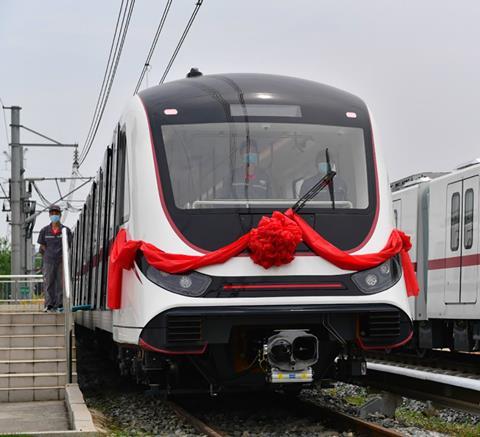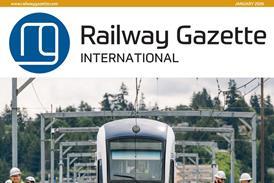
CHINA: Wuhan’s third driverless metro line was one of three expansion projects totalling 73 route-km to be inaugurated in the Hubei provincial capital on December 26. These take the city’s operational network to 435 km and 282 stations inaugurated since 2004.
Line 5 is the city’s third route to be equipped for driverless operation to Grade of Automation 4, following lines 7 and 8 opened in October 2018. It runs for 34·6 km on the south side of the Yangtse River, linking Hubei University of Chinese Medicine in the southwest to the East Square of Wuhan Railway Station in the northeast, and serving 25 stations in total. Much of the line is underground, but there is an 8·3 km elevated section at the southern end with four stations above ground. The line is operated by a fleet of 35 six-car trainsets, which are 140 m long, with a design capacity of 1 896 passengers and a crush load of 2 640. Maximum speed of the trains is 80 km/h.

Authorised by the National Development & Reform Commission in June 2015, Line 5 has been under construction since December of that year. Its formal opening at 09.56 on December 26 was timed to coincide with the start of construction of a southern extension of the line to Hongxiacun, which will add a further 2·6 km.
Hannan Line
The second line inaugurated at the same time was the 31·7 km Line 16 from Zhoujiahe to South International Expo Center, serving 16 stations. Also known as the Hannan Line, the suburban route running southwest alongside the Yangtse River includes a 20·3 km elevated section with five stations. The line is worked by 23 four-car Type A trainsets assembled locally at CRRC Group’s Wuhan Jiangan works. The 120 km/h trains have a design capacity for 896 passengers and a crush load of 1 240. However, all the stations on Line 16 have been built with provision for future expansion to six-car trains.
Line 16 was formally approved by the National Development & Reform Commission in December 2018, as part of the Wuhan Urban Rail Transit Phase IV Construction Plan (2019-24), in order to serve the Wuhan Development Zone in Hannan district. Construction had already started in July 2017 following the signing on January 26 of a framework co-operation agreement between the Wuhan Development Zone promoters and Wuhan Metro Group.
A second phase of Line 16 will see the route extended by 4·2 km along Shamao Avenue from Zhoujiahe to Xingcheng Dadao station in the General Aviation Industrial Park, adding a further two elevated stations.
The third route to be inaugurated on December 26 was a 7 km underground extension of Line 6 in the west of the city from Jinyinhu Park to Xincheng 11th Road Sancha.
Infill projects
As well as starting work on the extensions of lines 5 and 16, Wuhan Metro Group has also started the construction of two further routes. The Xingang Line, or Line 10, is intended to improve distribution from Wuhan Railway Station, in the eastern part of the city. The first phase will run for 10·9 km from Beiyangqiao in Yangchunhu to Baiyushan, serving five underground stations.
The so-called Line 12 connection project in the Jiang’an district of Hankou will see the suburban Yangluo Line, or Line 21, extended by 3·1 km from its current terminus at Houhou Dadao to Zhongyi Lu on Line 8, via an interchange with the orbital Line 12 now under construction. This fully underground link is intended to provide multiple route options and reduce congestion at the existing interchanges in the area.
Wuhan Metro Group has also started a demonstration project to centralise the management and control of the entire network on a cloud-based IT platform, creating what it calls ‘a smart subway with overall intelligence and efficient operation’. The Wuhan Rail Transit Information Cloud Platform is intended to support the management and information systems of up to 32 lines.and
- Read more about the development of the Wuhan metro network in the Autumn 2020 issue of Metro Report International magazine.









